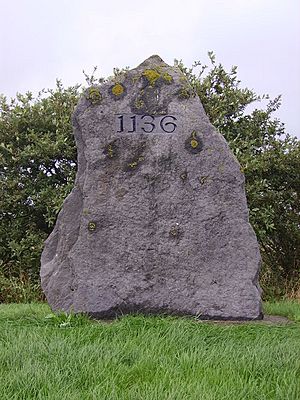Battle of Llwchwr facts for kids
Quick facts for kids Battle of Llwchwr |
|||||||
|---|---|---|---|---|---|---|---|
| Part of the Norman invasion of Wales | |||||||
 Commemoration stone of the Battle of Gower |
|||||||
|
|||||||
| Belligerents | |||||||
| Welsh forces from Brycheiniog and Northern Gŵyr | Norman forces from Southern Gŵyr | ||||||
| Commanders and leaders | |||||||
| Hywel ap Maredudd | Unknown | ||||||
| Strength | |||||||
| Unknown | Unknown | ||||||
| Casualties and losses | |||||||
| Unknown | 500 killed | ||||||
The Battle of Llwchwr (also known as the Battle of Gower) was an important fight in Welsh history. It happened between Welsh and Norman armies. The battle took place near the towns of Loughor and Swansea on New Year's Day in 1136.
Why the Battle of Llwchwr Happened
In the years 1135 and 1136, a big chance came for the Welsh people. They wanted to win back lands that had been taken by the Norman lords. These Norman lords were powerful rulers who controlled areas along the border of Wales, called the Marcher lands.
This opportunity came because of a big problem in England. The king, Stephen de Blois, had taken the throne. He had pushed aside his cousin, Matilda of England, who was supposed to be queen. This disagreement started a period of chaos in England known as the Anarchy. With England in turmoil, the Welsh saw their chance to fight for their freedom.
The Battle of Llwchwr: What Happened
A strong Welsh army was put together by Hywel ap Maredudd. He was a leader from Brycheiniog, an area now known as Brecknockshire. His army included men from Brycheiniog. It also had many men from Northern Gŵyr. These men really disliked the Norman rulers in Southern Gŵyr.
The Normans rode out, thinking they would only meet a few small groups of Welsh raiders. But they were very surprised by how many Welsh soldiers there were. The two armies met on a field called Carn Coch. There was a very fierce fight, a violent melee. The Welsh army fought bravely and won the battle. The Normans lost about 500 men in the fight.
After the Battle: What Changed
The Welsh victory at Llwchwr was a huge inspiration. It encouraged more rebellions and fights across Wales. For example, there was a battle near Kidwelly Castle. This battle was led by Gwenllian, who was a princess of Deheubarth. Another important battle that followed was the Battle of Crug Mawr.

